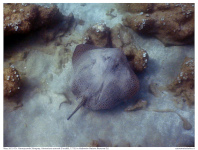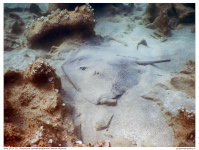Himantura uarnak
(Forsskål, 1775)
Honeycomb stingray
Classification: Elasmobranchii Myliobatiformes Dasyatidae
Reference of the original description
Descriptiones animalium, avium, amphibiorum, piscium, insectorum, vermium / quae in itinere orientali observavit Petrus Forskål. Post mortem auctoris edidit Carsten Niebuhr. Adjuncta est materia medica kahirina atque tabula maris Rubri geographica. Post mortem auctoris edidit Carsten Niebuhr. Hauniae. Descriptiones animalium quae in itinere ad Maris Australis terras per annos 1772 1773 et 1774 suscepto, ...: 1–20 + i–xxxiv + 1–164, map. [Pisces on pp. x–xix and 22–76.
Descriptiones animalium, avium, amphibiorum, piscium, insectorum, vermium / quae in itinere orientali observavit Petrus Forskål. Post mortem auctoris edidit Carsten Niebuhr. Adjuncta est materia medica kahirina atque tabula maris Rubri geographica. Post mortem auctoris edidit Carsten Niebuhr. Hauniae. Descriptiones animalium quae in itinere ad Maris Australis terras per annos 1772 1773 et 1774 suscepto, ...: 1–20 + i–xxxiv + 1–164, map. [Pisces on pp. x–xix and 22–76.
Image of the original description
No image in first description.
No image in first description.
Synonyms / new combinations and misspellings
Dasyatis uarnak, Dasyatis uarnak variegatus, Dasyatis (Himantura) uarnak, Dasybatis uarnak, Dasybatus uarnak, Himantura arnak, Himantura cf. uarnak, Himantura punctata, Himantura tutul, Himantura (Dasyatis) uarnak, Pastinachus uarnak, Raia arnak, Raia scherit, Raja arnak, Raja sephen uarnak , Raja uarnak, Trygon arnak, Trygon chindrakee, Trygon ellioti, Trygon punctata, Trygon uarnack, Trygon uarnak, Trygon variegatus, Trygon (Himantura) uarnak, Trygon (Himantura) variegatus
Dasyatis uarnak, Dasyatis uarnak variegatus, Dasyatis (Himantura) uarnak, Dasybatis uarnak, Dasybatus uarnak, Himantura arnak, Himantura cf. uarnak, Himantura punctata, Himantura tutul, Himantura (Dasyatis) uarnak, Pastinachus uarnak, Raia arnak, Raia scherit, Raja arnak, Raja sephen uarnak , Raja uarnak, Trygon arnak, Trygon chindrakee, Trygon ellioti, Trygon punctata, Trygon uarnack, Trygon uarnak, Trygon variegatus, Trygon (Himantura) uarnak, Trygon (Himantura) variegatus
Types
Himantura uarnak
Holotype: XXXX: No types known; Neotype: CAS: ICH 247241 (ex KAUST-RSRC-H006);
Himantura tutul
Holotype: MNHN: ICTI5184; Paratype: CSIRO: H5284.05; UMS: MMSK-c4;
Raia scherit
XXXX: No types known;
Raja sephen uarnak
XXXX: No types known;
Trygon punctata
Holotype: BMNH: 1953.8.10.15
Himantura uarnak
Holotype: XXXX: No types known; Neotype: CAS: ICH 247241 (ex KAUST-RSRC-H006);
Himantura tutul
Holotype: MNHN: ICTI5184; Paratype: CSIRO: H5284.05; UMS: MMSK-c4;
Raia scherit
XXXX: No types known;
Raja sephen uarnak
XXXX: No types known;
Trygon punctata
Holotype: BMNH: 1953.8.10.15
Description :
Citation: Himantura uarnak (Forsskål, 1775): In: Database of modern sharks, rays and chimaeras, www.shark-references.com, World Wide Web electronic publication, Version 04/2024
Please send your images of "Himantura uarnak" to info@shark-references.com
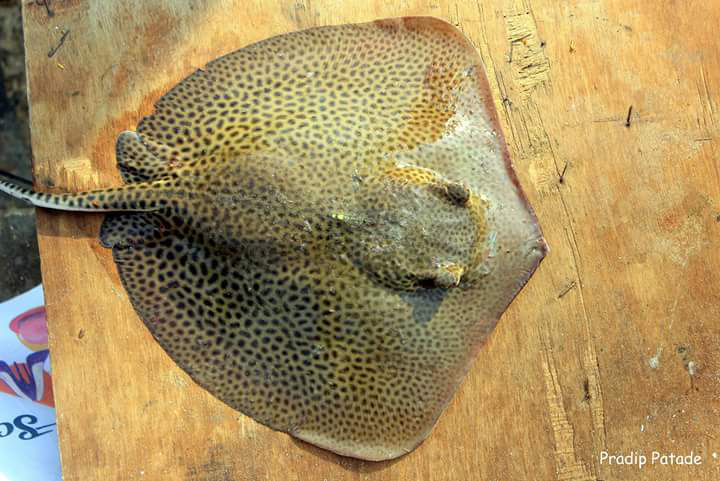
Himantura uarnak (Forsskål, 1775) adult, 61 cm DW, from Mumbai, India © Pradip Patade, India

Himantura uarnak (Forsskål, 1775) adult, 61 cm DW, from Mumbai, India © Pradip Patade, India
Common names
 Indo-Australischer Tüpfelrochen,
Indo-Australischer Tüpfelrochen,  Chupare oval,
Chupare oval,  Bouchée,
Bouchée,  Pastenague léopard,
Pastenague léopard,  Raie blanche,
Raie blanche,  Raie bouclee,
Raie bouclee,  Banded whiptail stingray,
Banded whiptail stingray,  Coachwhip ray,
Coachwhip ray,  Honeycomb,
Honeycomb,  Honeycomb stingray,
Honeycomb stingray,  Honeycombed stingray,
Honeycombed stingray,  Leopard ray,
Leopard ray,  Leopard stingray,
Leopard stingray,  Longtail ray,
Longtail ray,  Longtail stingray,
Longtail stingray,  Longtailed ray,
Longtailed ray,  Lontail ray,
Lontail ray,  Marbled sting ray,
Marbled sting ray,  Marbled stingray,
Marbled stingray,  Reticulate whip ray,
Reticulate whip ray,  Reticulate whipray,
Reticulate whipray,  Burá alveolado
Burá alveolado
 Indo-Australischer Tüpfelrochen,
Indo-Australischer Tüpfelrochen,  Chupare oval,
Chupare oval,  Bouchée,
Bouchée,  Pastenague léopard,
Pastenague léopard,  Raie blanche,
Raie blanche,  Raie bouclee,
Raie bouclee,  Banded whiptail stingray,
Banded whiptail stingray,  Coachwhip ray,
Coachwhip ray,  Honeycomb,
Honeycomb,  Honeycomb stingray,
Honeycomb stingray,  Honeycombed stingray,
Honeycombed stingray,  Leopard ray,
Leopard ray,  Leopard stingray,
Leopard stingray,  Longtail ray,
Longtail ray,  Longtail stingray,
Longtail stingray,  Longtailed ray,
Longtailed ray,  Lontail ray,
Lontail ray,  Marbled sting ray,
Marbled sting ray,  Marbled stingray,
Marbled stingray,  Reticulate whip ray,
Reticulate whip ray,  Reticulate whipray,
Reticulate whipray,  Burá alveolado
Burá alveolado
Short Description
Huge stingray with conspicuous dark spots on a light brown disc; spots well-spaced in young but crowded to form reticulated pattern in adult; white ventrally; tail marked with bands of black and white; snout sharply pointed; disc with narrowly rounded outer corners, and tail long, slender and nearly three times body length when intact, with no caudal finfolds; disc without thorns but with band of flat denticles along midback (in adults); usually 1 medium-sized sting on tail [536].
Huge stingray with conspicuous dark spots on a light brown disc; spots well-spaced in young but crowded to form reticulated pattern in adult; white ventrally; tail marked with bands of black and white; snout sharply pointed; disc with narrowly rounded outer corners, and tail long, slender and nearly three times body length when intact, with no caudal finfolds; disc without thorns but with band of flat denticles along midback (in adults); usually 1 medium-sized sting on tail [536].
Distribution
Indo-West Pacific: Red Sea (and eastern Mediterranean via Suez Canal) to southern Africa and French Polynesia, north to Taiwan, south to Australia. Also in the Arafura Sea (Ref. 9819). Collected from the estuary of the River Ganges [5700]. This name has been used for a number of similar spotted species [1388]. Probably a species complex [529]. Its identity has been confused in many publications and Micronesian specimens should be re-examined (Ref. 37816).
First records: Syrian coast (eastern Mediterranean) [27288] Source: www.gbif.org
Indo-West Pacific: Red Sea (and eastern Mediterranean via Suez Canal) to southern Africa and French Polynesia, north to Taiwan, south to Australia. Also in the Arafura Sea (Ref. 9819). Collected from the estuary of the River Ganges [5700]. This name has been used for a number of similar spotted species [1388]. Probably a species complex [529]. Its identity has been confused in many publications and Micronesian specimens should be re-examined (Ref. 37816).
First records: Syrian coast (eastern Mediterranean) [27288] Source: www.gbif.org
Human uses
fisheries: commercial; gamefish: yes
fisheries: commercial; gamefish: yes
Biology
Exhibit ovoviparity (aplacental viviparity), with embryos feeding initially on yolk, then receiving additional nourishment from the mother by indirect absorption of uterine fluid enriched with mucus, fat or protein through specialised structures [733]. Distinct pairing with embrace [17086]. Distinct pairing with embrace [17086]. Bears 3 to 5 young in the summer [536]. Size at birth about 21 [2539] - 28 cm WD [1388]. Common off sandy beaches and in shallow estuaries and lagoons; also found in sandy areas of coral reefs (Ref. 9710). Found on the continental shelf (Ref. 75154). Also offshore down to 50 m depth [536]. May enter fresh water [536]. Feeds on small fishes, bivalves, crabs, shrimps and worms.
Exhibit ovoviparity (aplacental viviparity), with embryos feeding initially on yolk, then receiving additional nourishment from the mother by indirect absorption of uterine fluid enriched with mucus, fat or protein through specialised structures [733]. Distinct pairing with embrace [17086]. Distinct pairing with embrace [17086]. Bears 3 to 5 young in the summer [536]. Size at birth about 21 [2539] - 28 cm WD [1388]. Common off sandy beaches and in shallow estuaries and lagoons; also found in sandy areas of coral reefs (Ref. 9710). Found on the continental shelf (Ref. 75154). Also offshore down to 50 m depth [536]. May enter fresh water [536]. Feeds on small fishes, bivalves, crabs, shrimps and worms.
Remarks
shark-references Species-ID=2925; Neotype maybe ot valid, see Eschmeyer's Catalog of Fishes: "Neotype (CAS 247241) designated by Borsa et al. 2020:[5] [ref. 37984], but specimen too small to sufficiently characterize the species, therefore neotype invalid; ref. 37984 is also lacking fixed content and layout, and neotype designation therefore unavailable according to ICZN 8.1.3.2."
shark-references Species-ID=2925; Neotype maybe ot valid, see Eschmeyer's Catalog of Fishes: "Neotype (CAS 247241) designated by Borsa et al. 2020:[5] [ref. 37984], but specimen too small to sufficiently characterize the species, therefore neotype invalid; ref. 37984 is also lacking fixed content and layout, and neotype designation therefore unavailable according to ICZN 8.1.3.2."
Parasites (arranged by Jürgen Pollerspöck)
Monogenea
Cestoda
Nematoda
Copepoda
Hirudinea
Monogenea
- Dendromonocotyle colorni Chisholm, Whittington & Kearn, 2001 [9437] [9445] [21242] [9460]
- Dendromonocotyle ukuthena Vaughan, Chisholm & Christison, 2008 [21242] [27172]
- Empruthotrema dasyatidis Whittington & Kearn, 1992 [7581]
- Heterocotyle armata Timofeeva, 1983 [9644]
- Heterocotyle chinensis Timofeeva, 1983 [9644]
- Heterocotyle confusa Timofeeva, 1983 [9644]
- Heterocotyle granulatae Young, 1967 [9644]
- Merizocotyle australensis (Beverley-Burton & Williams, 1989) Chisholm, Wheeler & Beverley-Burton, 1995 [17044] [17002]
- Monocotyle helicophallus Measures, Beverley-Burton & Williams, 1990 [9642]
- Monocotyle multiparous Measures, Beverley-Burton & Williams, 1990 [9642]
- Monocotyle sp. [17001]
- Monocotyle spiremae Measures, Beverley-Burton & Williams, 1990 [9642]
- Trimusculotrema uarnaki Whittington & Barton, 1990 [17452]
Cestoda
- Acanthobothrium cannoni Campbell & Beveridge, 2002 [16128] [28741]
- Acanthobothrium longipedunculata Uma Maheswari, Vijaya Lakshmi & Hanumantha Rao, 1985 [16223] [28741]
- Acanthobothrium waltairensis Uma Maheswari, Sarada Sanaka, Vijaya Lakshmi & Hanumantha Rao, 1987 [16431] [28741]
- Anthobothrium loculatum Lakshmi & Sarada, 1993 [8182]
- Anthocephalum philruschi Ruhnke, Caira & Cox, 2015 [22027]
- Dollfusiella angustiformis Schaeffner & Beveridge, 2013 [21816]
- Dollfusiella hemispinosa Schaeffner & Beveridge, 2013 [19694] [21816]
- Dollfusiella owensi (Beveridge, 1990) Beveridge & Jones, 2000 [16252] [16112]
- Dollfusiella sp. [16112] [15730]
- Dollfusiella spinulifera (Beveridge & Jones, 2000) [19694] [21816]
- Echinobothrium reesae Ramadevi, 1969 [16379] [16430]
- Eutetrarhynchus sp. [16252] [29720]
- Halysiorhynchus macrocephalus (Shipley & Hornell, 1906) [16112]
- Hornelliella annandalei (Shipley & Hornell, 1912) Yamaguti, 1954 [16112]
- Kotorella pronosoma (Stossich, 1901) [15730] [21816] [32432]
- Parachristianella baverstocki Beveridge, 1990 [16252] [16112]
- Parachristianella indonesiensis Palm, 2004 [15730] [21816]
- Parachristianella monomegacantha Kruse, 1959 [15730] [21816]
- Polypocephalus visakhapatnamensis Vankara, Vijayalakshmi & Gangadharam, 2007 [16432]
- Prochristianella aciculata Beveridge & Justine, 2010 [17404] [21816]
- Prochristianella butlerae Beveridge, 1990 [21816]
- Prochristianella clarkeae Beveridge, 1990 [16252] [16112] [17404] [21816]
- Prochristianella kostadinovae Schaeffner & Beveridge, 2012 [17404]
- Pterobothrium sp. [16112]
- Rhinebothrium insignia Southwell, 1911 [17129] [16247]
- Rhinoptericola aetobatidis (Shipley & Hornell, 1906) [15747] [21816]
- Rhinoptericola butlerae (Beveridge & Campbell, 1988) [30611]
- Rhinoptericola jensenae (Schaeffner & Beveridge, 2012) [17404]
- Seussapex karybares Jensen & Russell, 2014 [21148] [23959]
- Seussapex sp. [23959]
- Stillabothrium borneoense Herzog, Meininger & Reyda, 2021 [30048]
- Stillabothrium davidcynthiaorum Daigler & Reyda, 2016 [24898]
- Thysanobothrium uarnakense Shipley & Hornell, 1905 [16338]
- Trygonicola macroporus (Shipley & Hornell, 1906) [16256] [16112] [15730] [21816]
- Tylocephalum chiralensis Vijayalakshmi & Sarada, 1995 [8186]
- Uncibilocularis sidocymba Jensen & Caira, 2008 [16092]
- Uncibilocularis squireorum Jensen & Caira, 2008 [16092]
- Zygorhynchus elongatus Beveridge & Campbell, 1988 [16255] [16112]
- Zygorhynchus robertsoni Beveridge & Campbell, 1988 [16255] [16112]
Nematoda
- Echinocephalus overstreeti Deardorff & Ko, 1983 [21500]
- Porrocaecum dasyatum Rajyalakshmi & Lakshmi, 1995 [21502]
Copepoda
- Caligus elasmobranchi Boxshall, 2018 [26229]
Hirudinea








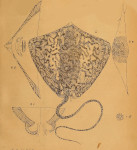
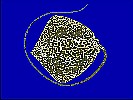
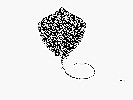
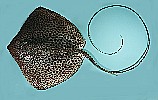
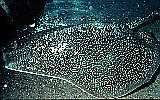
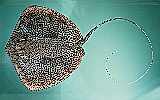

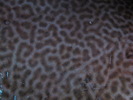
.JPG)
.JPG)
.JPG)
.JPG)
